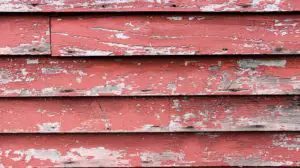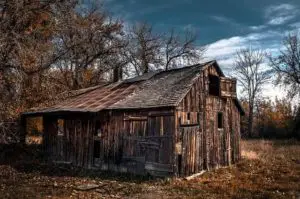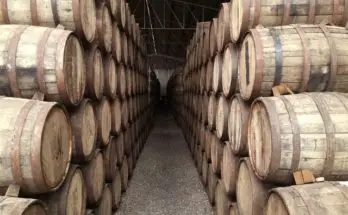If you have ever gone to a craft show and looked at buying a piece that was made of reclaimed lumber, you may have encountered some sticker shock. The easy assumption to make is that the person selling the piece has overpriced their work and is trying to make a huge profit off each sale. While that could very well be the case, odds are, the crafter’s material cost for the wood they used was a significant reason for the high selling price.
Reclaimed lumber is expensive for a number of reasons. The driving force behind the high prices is the difficulty of obtaining this type of lumber and the fact that there’s only a limited supply. There are several steps involved with getting reclaimed wood ready to be used in any project.
Below we will look more into each item that is driving the high prices. If you would like to see my buyers guide to getting reclaimed wood, check out this article.
Unique Characteristics
Reclaimed wood has properties that sets it apart from anything you can find at your local big box store or lumber yard. Reclaimed lumber is often used from old structures that can be anywhere from several decades old to a century or more. The age of this wood does two things. First, it can create a weathered look depending on the manner in which it was used. If it was used on the side of a barn, the elements of the weather will have had an effect upon the exposed wood for decades. This is an aging process that cannot be re-created any other way.
 Even using boards that have been indoors can prove to have significant amount of character added just through the normal wear and tear that it sees. In fact, if you’ve never seen dining tables or countertops made from reclaimed bowling alley lanes or railroad box cars, you should definitely check them out.
Even using boards that have been indoors can prove to have significant amount of character added just through the normal wear and tear that it sees. In fact, if you’ve never seen dining tables or countertops made from reclaimed bowling alley lanes or railroad box cars, you should definitely check them out.
The other unique quality that causes reclaimed wood to be so different than modern day lumber is the properties of the wood within itself. Wood that was harvested a half century or more ago is much better quality than the lumber that you find on the shelves of stores today.
The lumber today is often harvested from tree farms that were planted with trees that would grow quickly. In addition, fertilizers and other growing methods were used to increase their growth rate. These unnatural practices of growing trees change their molecular makeup during their growth cycles.
These differences in their physically makeup is visible in a number of ways. First off, if you hold a piece of wood that is a century old next to a piece of the same species that you recently purchased at your local big box store, you should see a significant difference in the look of the end grain.
Next, you will also see considerable difference in the weight of items. This will be easier to see in furniture. If you compare the weight of the same piece made with reclaimed wood vs modern wood, you’ll see a very noticeable difference in the weight of the pieces.
The last primary difference in these two types of wood is the strength of them. Reclaimed wood (assuming it isn’t rotted) is much stronger. This ties back to our first point of the molecular makeup being different. Since the older wood is denser, it holds together much better.
As you can see, a piece of pine from a 100 year old building is much different than what you are going to buy somewhere today. Because harvesting and reforestation processes are different today and focused more on re-growing quantity instead of quality, the characteristics of reclaimed wood are not easily replicated. Therefore, the supply for this lumber is much more limited and less prevalent. That in itself will drive up the price.
Harvesting Reclaimed Wood
The next major factor impacting the price on reclaimed wood is the process that is required to acquire it and prepare it for sale. This process can vary significantly based on the age of the wood and the environment it has been in. For instance, it will be much easier to prep wood from an old bowling alley rather than lumber from a 100 year old barn.
For resellers of reclaimed wood, the first step in their process is actually finding good quality wood that can be resold with as little prep work as possible. When wood becomes available from somewhere like a bowling alley or railroad box cars, the demand for these products is high. Resellers are willing to pay a premium for this type of wood because it’s in relatively good shape and the uniqueness of the boards.
Finding a Structure
For resellers that aren’t able to get in on deals like the bowling alley lanes, they are going to be forced to look for reclaimed wood from other sources such as old buildings, houses or barns. Many times, potential reclaimed wood sellers will approach local farms about selling them the rights to their barns. This process isn’t as easy as it may sound. Many times, these barns or structures have been in the family for decades and the thought of having them torn down can be difficult, even if the structure is already starting to collapse on its own.
Another factor that makes farmers hesitate to allow someone to take down their barn or structure is liability concerns. Tearing down an old barn is extremely dangerous work and requires attention to detail. If you don’t take your time and deconstruct the building properly, you are likely to cause significant damage to the wood you are trying to salvage. This may require climbing into the rafters of the barn and removing boards one by one. If the people doing these tasks don’t know what they are doing, it could result in serious injury.
 Many of the companies that specialize in taking these old structures apart are responsible and experienced enough to have insurance in place. They will present farmers with a contract that lays everything out and releases them from the liability of any injury that may happen to occur.
Many of the companies that specialize in taking these old structures apart are responsible and experienced enough to have insurance in place. They will present farmers with a contract that lays everything out and releases them from the liability of any injury that may happen to occur.
Farmers also want to ensure that the structure is going to be completely removed. When a contract isn’t put in place, the farmer is at risk of their barn or structure being harvested of all the high quality pieces, and then the demo company not returning to completely clean up the site. Then the land owner is forced to finish the work himself or pay to having someone do it.
Prepping the supply
Once the contract has been signed, the reseller or demo company gets to work removing the structure. Depending on the size, this tedious process can take anywhere from a couple days to several weeks. Often times, the people taking it apart will sort the wood as it comes apart based on it’s type (wide boards, beams, metal, etc).
Once the boards have been transported to the new owners property, the next stage of work is not easier. Most DIY’ers want their wood free of nails when they buy them so they don’t harm their saws when cutting. That means the new owners of the wood will go thru the wood and pull the nails from each board.
When buying reclaimed wood for your projects, it’s always good to run a magnet over the boards to ensure every piece of metal has been removed. Many times, nails will break or random pieces of metal will get stuck in the wood. It’s always better to find these with a magnet than with your saw blade. The magnet doesn’t have to be anything fancy. In fact, I use this basic magnetic stud finder unit and it does an excellent job.
De-nailing the wood is typically the last step before making the wood available for sale to general DIY’ers. Some sellers may quickly spray their wood with some water to wash some of the dirt off, but it’s not very common. Another step that is often skipped and can lead to costly issues if the end user of the wood is ensuring the wood is bug and insect free.
 Reclaimed wood is typically pulled from abandoned structures. These buildings are prime locations for bugs and insects to build their homes in. Many times, these insects will bore into the wood and build their homes or lay eggs. The best way to make sure all the insects have been killed before using the wood is to run it through a kiln. Most resellers don’t have access to a kiln so they skip this step.
Reclaimed wood is typically pulled from abandoned structures. These buildings are prime locations for bugs and insects to build their homes in. Many times, these insects will bore into the wood and build their homes or lay eggs. The best way to make sure all the insects have been killed before using the wood is to run it through a kiln. Most resellers don’t have access to a kiln so they skip this step.
Assuming the end user of the wood doesn’t have access to a kiln, the only other way to eliminate the threat of bugs is to use chemicals. Fortunately, there are treatments available that are not dangerous to humans. I highly recommend applying a coat of BoraCare to your reclaim to ensure the wood is not infested with insects. Application is easy and only requires a sprayer or paint brush. Here’s a link to purchase a gallon of it. You can find my complete guide to treating reclaimed wood for bugs here.
Closing
As you can see, the process for obtaining reclaimed wood is a long and difficult journey. Once a structure is found, it can be several months before any of the wood from it is available for sale because of the work needed to get it ready. On top of the difficulty in finding and preparing it, the supply for reclaimed wood is not infinite. Reclaimed wood often comes from trees that were harvested decades ago and have gained character than cannot be created without extended periods of time.
For a look at whether or not reclaim wood usage in home decor is likely to go out of style, you should check out my other article here.




